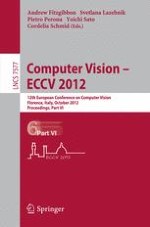2012 | Buch
Computer Vision – ECCV 2012
12th European Conference on Computer Vision, Florence, Italy, October 7-13, 2012, Proceedings, Part VI
herausgegeben von: Andrew Fitzgibbon, Svetlana Lazebnik, Pietro Perona, Yoichi Sato, Cordelia Schmid
Verlag: Springer Berlin Heidelberg
Buchreihe : Lecture Notes in Computer Science
